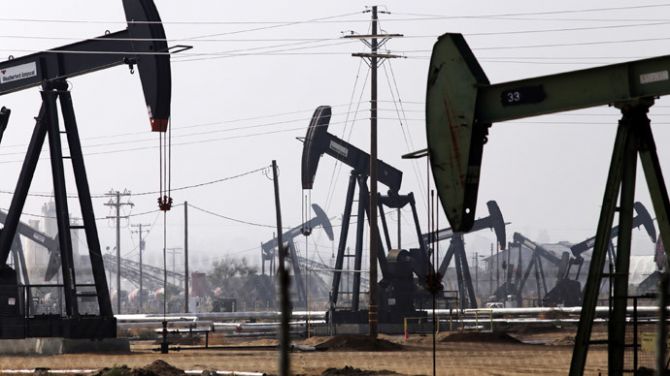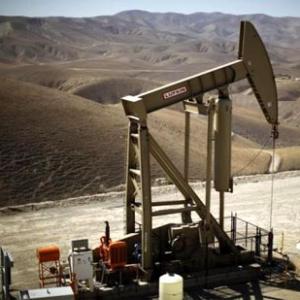 From February to mid-March, oil prices receded rapidly. WTI dropped by 22 per cent in six weeks. Brent crude was down about 15 per cent.
From February to mid-March, oil prices receded rapidly. WTI dropped by 22 per cent in six weeks. Brent crude was down about 15 per cent.
Then, in the past four weeks, the oil inched back up to the price levels at the start of February.
Late January, Baker Hughes data showed US rig counts had fallen significantly in the preceding six months.
This was expected to help curtail supply, and lead to an increase in prices.
Along with this, the impact of weather in Iraq and violence in Libya curtailed production and lead to a rally in prices in January.
Even though the rig count had reduced from a peak of about 1,600 to 900 in March, during the same time oil production went up from about 9 million barrels a day (mbpd) to 9.37 mbpd, the highest level in the US since 1982.
This was because the producers were focusing on their most productive wells and increasing output from them.
In April, Barker Hughes reported the rig count had further reduced to 760.
Now, production trend seems to changing as well.
EIA estimates that output from two big shale plays in the US, Eagle Ford and Bakken, are expected to decline in May while output from Permian will continue to grow.
Deutsche Bank, in a report, suggested that US production will hit an inflection point in May.
People are arguing that the rig count reduction (factored in for productivity gains) will finally start showing its impact on reduced US production in later half of this year.
This along with the risk premium caused by tension in middle east over Saudi-led attacks on Yemen is adding a premium to prices.
Yemen itself is not a significant producer of oil but next to it passes the fourth busiest oil shipping bottleneck of the world.
At the same time supply disruptions from Iraq and Libya have reduced.
Over this time, the US stockpiles have built up to record levels, getting to the highest inventory level in last 33 years with the hope that as soon as oil prices recover they can sell it.
There is also a big invisible inventory that is building up.
A number of producers are leaving their wells almost complete but not starting production from them.
This means that a huge amount of oil is available to start production.
Wood Mackenzie and RBC Capital Markets estimate that over 3,000 wells have been drilled but not tapped.
Then, there is the possibility of Iran ramping up production in case the US-Iran talks end up being positive and ease the sanctions.
Iran, says it can ramp-up production by 1 mbpd within a few months of sanctions being lifted.
Experts suggest it may be more reasonable to assume that Iran can only ramp up production by 0.3 mbpd and to get to 1 mbpd will be a longer cycle.
Besides, while the US rig count has been declining Saudi rig count has gone up 5-6 per cent. It is also reported that Saudi production has increased to 10.3 mbpd the highest in last 13 years.
In Russia, as the small simple refineries called teapots get dis-incentivised to process crude, up to 250,000 barrels per day may become available for sale.
As per Bloomberg, loadings from Russian ports were 9.5 per cent higher in the first quarter of 2015 over last year.
Along with this the short term demand from China may be tapering off. Reports suggest that China may have filled their current strategic reserves and will buy more only after construction of additional strategic reserve storages.
The oversupply, the pending US interest rates hike and the associated dollar strength can all add to downward pressure on oil prices.
Till now, we have not really seen production ramping down because OPEC is not backing down and shale producers are producing more to meet their cash flow obligations.
Long-term supply will be impacted by 35-40 per cent cut in capital expenditure by oil companies in 2015. Shell, for instance, said it would cut spending by $15 billion.
Chevron announced a cut of $5 billion. As the refinery maintenance season ends in the US, the demand should go back up, and high stockpiles should start reducing.
In the medium term, the reduction in rig counts should start resulting in less supply from new fields, and in the long term the reduction in capital expenditure should taper off supply growth.
However, in the short term, the inventories will prevent an immediate and sharp price rise even after production falls.
Crude may see modest gains in price through end of this year, however, it will take a while before oil scales $100 again.
Aditya Gandhi is director, Sapient Global Markets (India)










